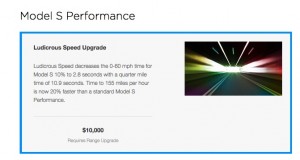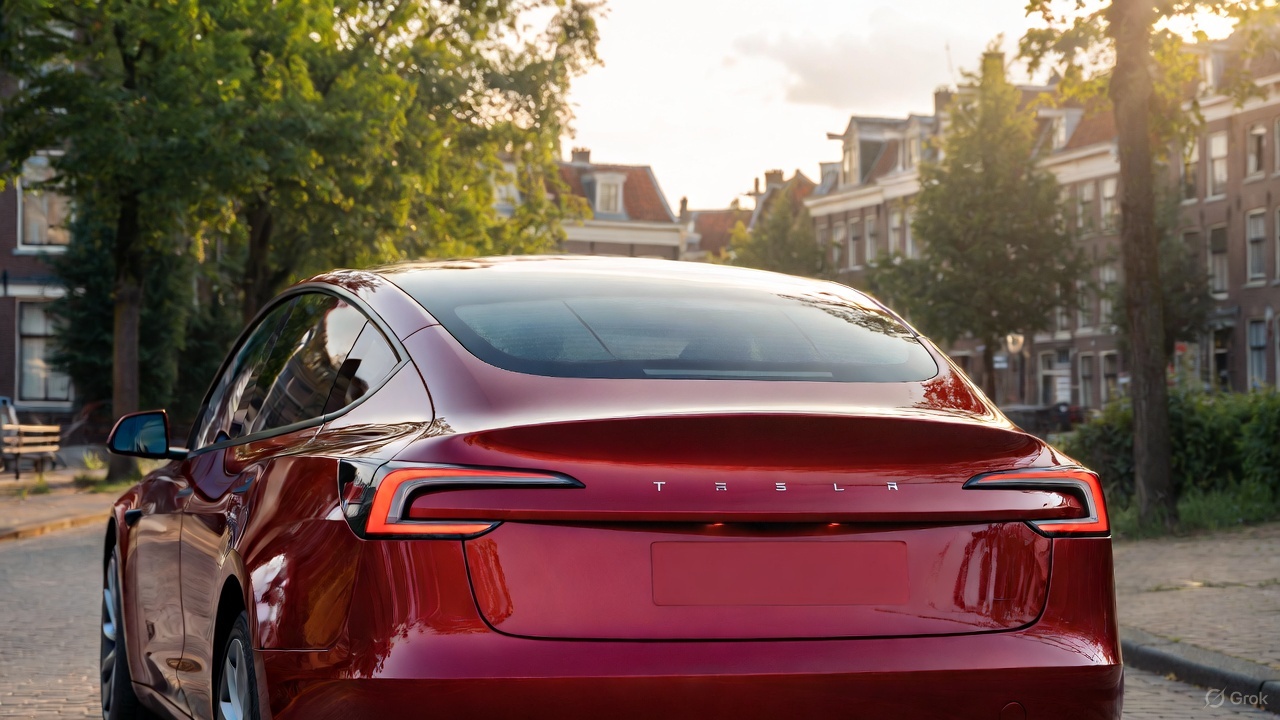

News
Watch Out: Tesla Model 3 Will Have Ludicrous Mode
The Model 3 could be the quickest Tesla ever
There could be a new king of the hill when it comes to being the quickest accelerating car in Tesla’s vehicle lineup if the latest tweet by Elon Musk holds true. When asked by @vigneshraju of Twitter on whether the Model 3 will have Ludicrous mode, Musk replied with a simple “of course”.
The remark has left many reservation owners across Twitter and forum groups to speculate on the type of battery, price, and performance improvement Ludicrous mode will bring to Tesla’s entry-level vehicle.
@vigneshraju of course
— Elon Musk (@elonmusk) April 30, 2016
Ludicrous mode was first introduced as an optional hardware upgrade to the Model S P85D: an upgrade that would allow the battery to draw more current, from 1300 to 1500 amps, and allow the electric motors to temporarily produce more power. The end result is unrivaled acceleration capable of catapulting the Model S from 0 – 60 mph in a blistering 2.6 seconds and down the 1/4 mile at 10.9 seconds, according to tests conducted by Motor Trend.
What will this mean in terms of performance when Ludicrous mode is enabled on a presumably much lighter Model 3 with smaller battery pack? And more importantly, how will this upgrade impact the overall cost of the vehicle?
Price of Tesla Model 3 with Ludicrous Mode
Make no mistake that 400k reservations of the Model 3 is largely due to the fact that it has a low cost of entry. At $35k you’re buying proven electric vehicle technology, low cost of ownership (cost per mile), and brand prestige.
 We know the base Model 3 will come standard in a rear wheel drive configuration, but add in dual motors – required in Tesla’s top of the line Performance models – electronically controlled air suspension (also required), and the optional rip-your-head-off Ludicrous mode upgrade, it wouldn’t be too far-fetched to double the cost of the vehicle. After all the Ludicrous Speed Upgrade on the Model S and X alone costs $10k, and that’s on top of the additional price paid to upgrade to the flagship Performance variation.
We know the base Model 3 will come standard in a rear wheel drive configuration, but add in dual motors – required in Tesla’s top of the line Performance models – electronically controlled air suspension (also required), and the optional rip-your-head-off Ludicrous mode upgrade, it wouldn’t be too far-fetched to double the cost of the vehicle. After all the Ludicrous Speed Upgrade on the Model S and X alone costs $10k, and that’s on top of the additional price paid to upgrade to the flagship Performance variation.
All said and done, a fully loaded Model 3 could reach $70k and surpass the base price of the Model S. But that won’t stop 15% of Model 3 buyers from going Insane to Ludicrous.
Tesla Model 3 Ludicrous Mode Performance
We know Ludicrous Teslas are quick. We recently saw the 6,000 pound Model X SUV destroy a Ferrari in a test of acceleration, and we’ve even witnessed a Ludicrous-enabled P90D Model S sedan take on a Boeing 737 jet. But will Tesla allow its entry-level vehicle surpass the performance of an equally-equipped Model S or Model X? The answer is likely no.
Accelerating quickly requires power derived from the battery. Current and voltage affects the amount of power the inverter delivers to the electric motors. But because the Model 3 will likely have a smaller battery, in order to keep costs down, the voltage produced from a smaller battery pack is lower than that of a larger pack, resulting in less power.
The Model S 70D is capable of accelerating to 60 mph in 5.2 seconds. Assuming the Performance version of the Model 3 will have a tuned version of the 70D battery with higher voltage, combined with a lower overall vehicle curb weight than the Model S, it wouldn’t be surprising if we saw low 3 second 0-60 mph times. It’s still quicker than Elon’s favorite performance benchmark the McLaren F1, while leaving bragging rights to its older and more expensive siblings.

Elon Musk
Tesla CEO Elon Musk sends rivals dire warning about Full Self-Driving

Tesla CEO Elon Musk revealed today on the social media platform X that legacy automakers, such as Ford, General Motors, and Stellantis, do not want to license the company’s Full Self-Driving suite, at least not without a long list of their own terms.
“I’ve tried to warn them and even offered to license Tesla FSD, but they don’t want it! Crazy,” Musk said on X. “When legacy auto does occasionally reach out, they tepidly discuss implementing FSD for a tiny program in 5 years with unworkable requirements for Tesla, so pointless.”
I’ve tried to warn them and even offered to license Tesla FSD, but they don’t want it! Crazy …
When legacy auto does occasionally reach out, they tepidly discuss implementing FSD for a tiny program in 5 years with unworkable requirements for Tesla, so pointless. 🤷♂️
🦕 🦕
— Elon Musk (@elonmusk) November 24, 2025
Musk made the remark in response to a note we wrote about earlier today from Melius Research, in which analyst Rob Wertheimer said, “Our point is not that Tesla is at risk, it’s that everybody else is,” in terms of autonomy and self-driving development.
Wertheimer believes there are hundreds of billions of dollars in value headed toward Tesla’s way because of its prowess with FSD.
A few years ago, Musk first remarked that Tesla was in early talks with one legacy automaker regarding licensing Full Self-Driving for its vehicles. Tesla never confirmed which company it was, but given Musk’s ongoing talks with Ford CEO Jim Farley at the time, it seemed the Detroit-based automaker was the likely suspect.
Tesla’s Elon Musk reiterates FSD licensing offer for other automakers
Ford has been perhaps the most aggressive legacy automaker in terms of its EV efforts, but it recently scaled back its electric offensive due to profitability issues and weak demand. It simply was not making enough vehicles, nor selling the volume needed to turn a profit.
Musk truly believes that many of the companies that turn their backs on FSD now will suffer in the future, especially considering the increased chance it could be a parallel to what has happened with EV efforts for many of these companies.
Unfortunately, they got started too late and are now playing catch-up with Tesla, XPeng, BYD, and the other dominating forces in EVs across the globe.
News
Tesla backtracks on strange Nav feature after numerous complaints

Tesla is backtracking on a strange adjustment it made to its in-car Navigation feature after numerous complaints from owners convinced the company to make a change.
Tesla’s in-car Navigation is catered to its vehicles, as it routes Supercharging stops and preps your vehicle for charging with preconditioning. It is also very intuitive, and features other things like weather radar and a detailed map outlining points of interest.
However, a recent change to the Navigation by Tesla did not go unnoticed, and owners were really upset about it.
For trips that required multiple Supercharger stops, Tesla decided to implement a naming change, which did not show the city or state of each charging stop. Instead, it just showed the business where the Supercharger was located, giving many owners an unwelcome surprise.
However, Tesla’s Director of Supercharging, Max de Zegher, admitted the update was a “big mistake on our end,” and made a change that rolled out within 24 hours:
The naming change should have happened at once, instead of in 2 sequential steps. That was a big miss on our end. We do listen to the community and we do course-correct fast. The accelerated fix rolled out last night. The Tesla App is updated and most in-car touchscreens should…
— Max (@MdeZegher) November 20, 2025
The lack of a name for the city where a Supercharging stop would be made caused some confusion for owners in the short term. Some drivers argued that it was more difficult to make stops at some familiar locations that were special to them. Others were not too keen on not knowing where they were going to be along their trip.
Tesla was quick to scramble to resolve this issue, and it did a great job of rolling it out in an expedited manner, as de Zegher said that most in-car touch screens would notice the fix within one day of the change being rolled out.
Additionally, there will be even more improvements in December, as Tesla plans to show the common name/amenity below the site name as well, which will give people a better idea of what to expect when they arrive at a Supercharger.
News
Dutch regulator RDW confirms Tesla FSD February 2026 target
The regulator emphasized that safety, not public pressure, will decide whether FSD receives authorization for use in Europe.

The Dutch vehicle authority RDW responded to Tesla’s recent updates about its efforts to bring Full Self-Driving (Supervised) in Europe, confirming that February 2026 remains the target month for Tesla to demonstrate regulatory compliance.
While acknowledging the tentative schedule with Tesla, the regulator emphasized that safety, not public pressure, will decide whether FSD receives authorization for use in Europe.
RDW confirms 2026 target, warns Feb 2026 timeline is not guaranteed
In its response, which was posted on its official website, the RDW clarified that it does not disclose details about ongoing manufacturer applications due to competitive sensitivity. However, the agency confirmed that both parties have agreed on a February 2026 window during which Tesla is expected to show that FSD (Supervised) can meet required safety and compliance standards. Whether Tesla can satisfy those conditions within the timeline “remains to be seen,” RDW added.
RDW also directly addressed Tesla’s social media request encouraging drivers to contact the regulator to express support. While thanking those who already reached out, RDW asked the public to stop contacting them, noting these messages burden customer-service resources and have no influence on the approval process.
“In the message on X, Tesla calls on Tesla drivers to thank the RDW and to express their enthusiasm about this planning to us by contacting us. We thank everyone who has already done so, and would like to ask everyone not to contact us about this. It takes up unnecessary time for our customer service. Moreover, this will have no influence on whether or not the planning is met,” the RDW wrote.
The RDW shares insights on EU approval requirements
The RDW further outlined how new technology enters the European market when no existing legislation directly covers it. Under EU Regulation 2018/858, a manufacturer may seek an exemption for unregulated features such as advanced driver assistance systems. The process requires a Member State, in this case the Netherlands, to submit a formal request to the European Commission on the manufacturer’s behalf.
Approval then moves to a committee vote. A majority in favor would grant EU-wide authorization, allowing the technology across all Member States. If the vote fails, the exemption is valid only within the Netherlands, and individual countries must decide whether to accept it independently.
Before any exemption request can be filed, Tesla must complete a comprehensive type-approval process with the RDW, including controlled on-road testing. Provided that FSD Supervised passes these regulatory evaluations, the exemption could be submitted for broader EU consideration.









